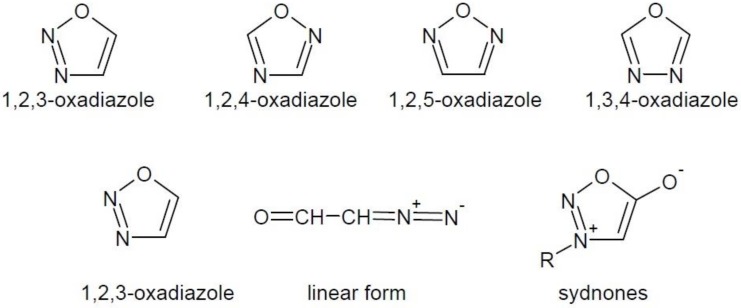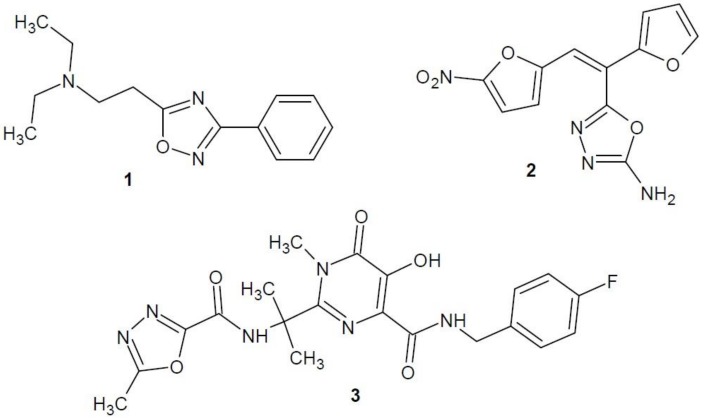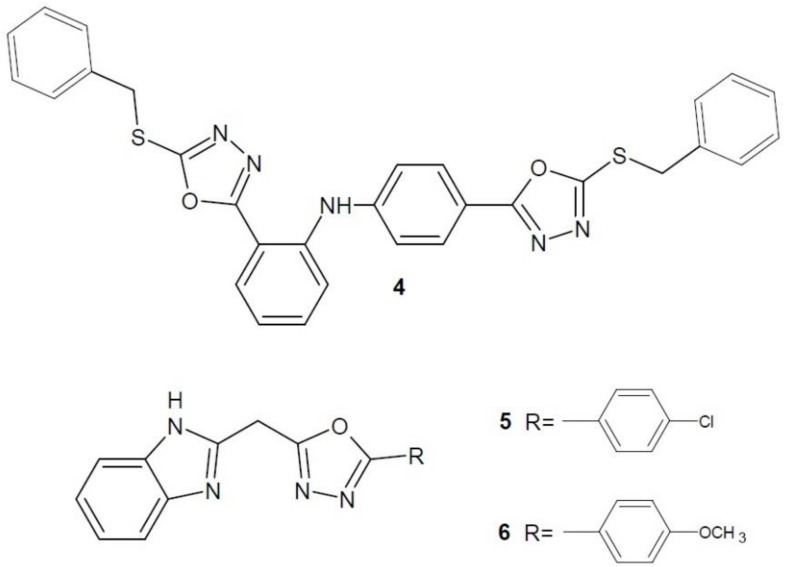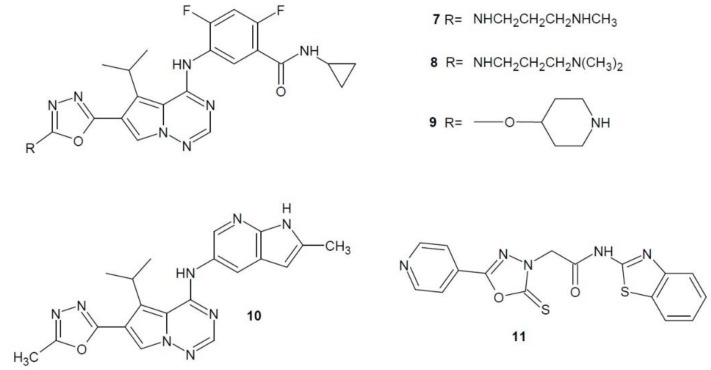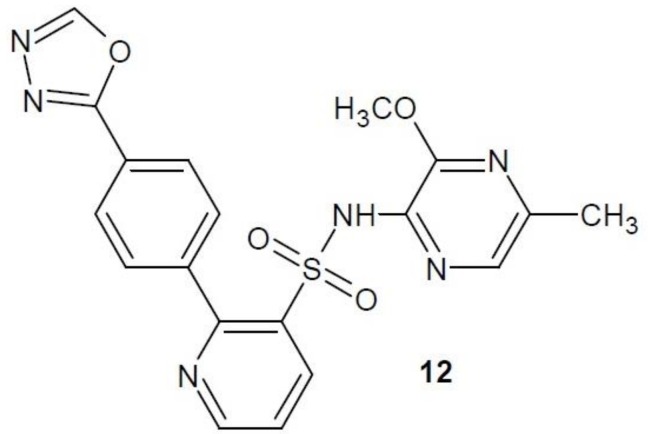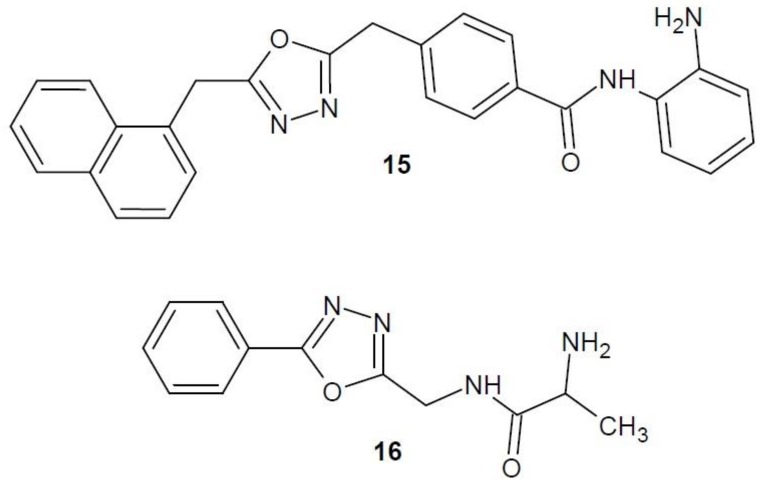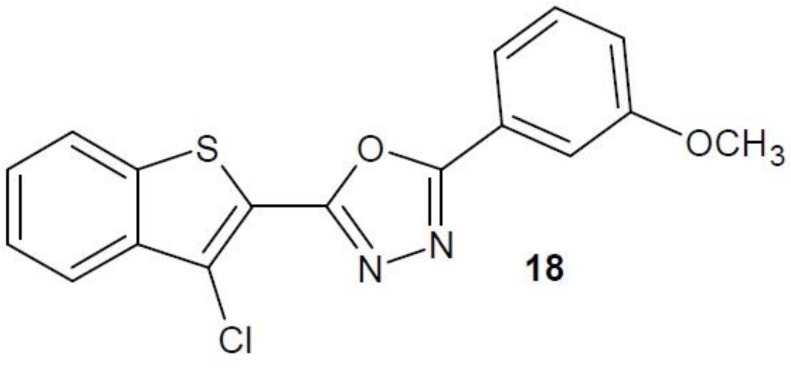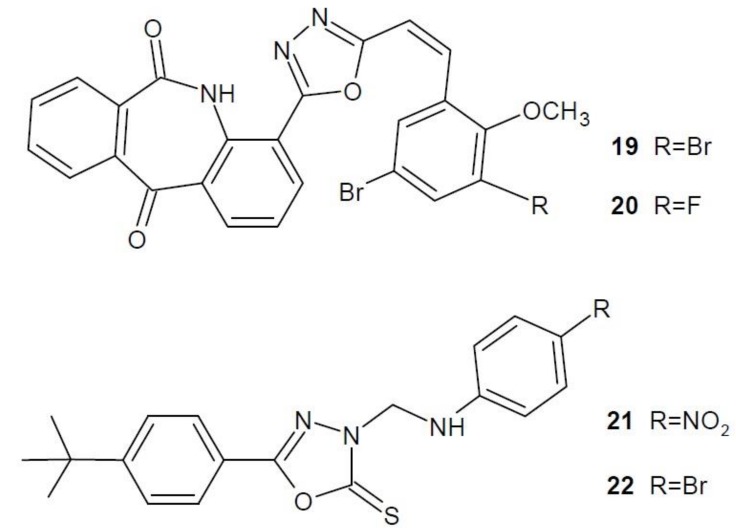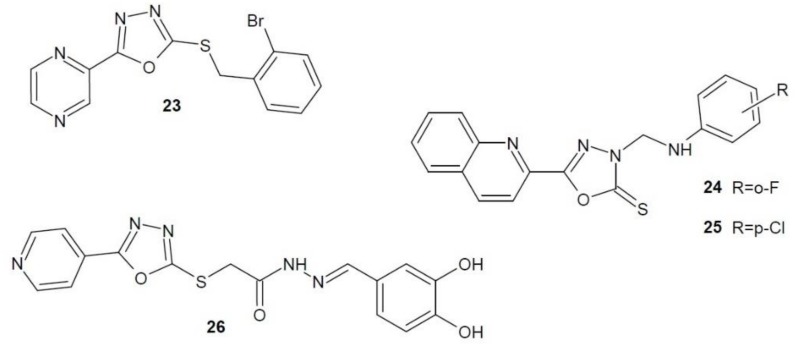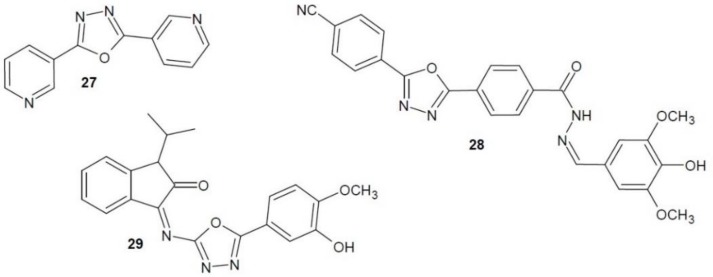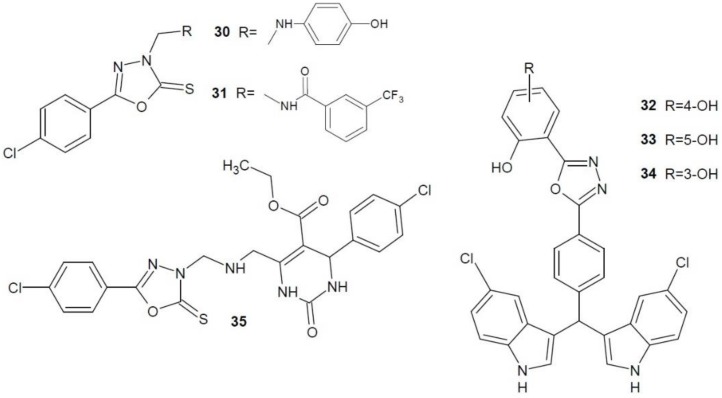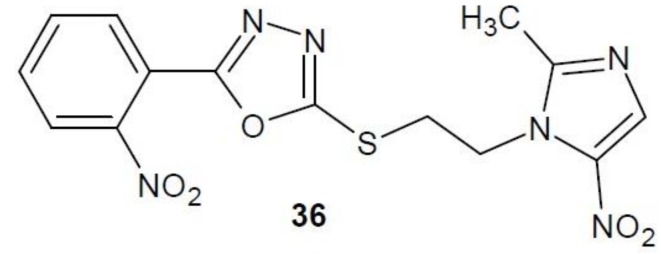Abstract
Compounds containing 1,3,4-oxadiazole ring in their structure are characterised by multidirectional biological activity. Their anti-proliferative effects associated with various mechanisms, such as inhibition of growth factors, enzymes, kinases and others, deserve attention. The activity of these compounds was tested on cell lines of various cancers. In most publications, the most active derivatives of 1,3,4-oxadiazole exceeded the effect of reference drugs, so they may become the main new anti-cancer drugs in the future.
Keywords: 1,3,4-oxadiazole; anti-proliferative activity; anti-cancer drugs
1. Introduction
Around the world research is underway to find new anti-cancer drugs. The constant increase in the incidence [1], the numerous side effects of the drugs currently in use [2], as well as the developing resistance of tumours to drugs [3] force the continuous search for new molecules with a safer effect profile. New synthetic anti-cancer compounds are most often heterocyclic derivatives, whereby structures containing a 1,3,4-oxadiazole ring constitute a group of compounds with exceptionally high cytostatic potential.
Oxadiazoles are five-membered heterocyclic compounds containing two nitrogen atoms and one oxygen atom in their structure. They occur in several isomeric forms (Figure 1).
Figure 1.
Isomeric forms of oxadiazole and modifications of unstable ring of 1,2,3-oxadiazole.
The 1,2,3-oxadiazole ring is unstable and is tautomerised to diazo-ketone linear form. It does not occur in the free form, but in rare mesoionic forms, called sydnones [4] (Figure 1). The other oxadiazole isomers are well known and occur in the structure of many drugs, e.g., antitussive oxolamine (1), antimicrobial furamizole (2), antiviral raltegravir (3) and others (Figure 2).
Figure 2.
Drugs with oxadiazole core.
Particularly noteworthy are the derivatives of 1,3,4-oxadiazole. The presence of the 1,3,4-oxadiazole ring affects the physicochemical and pharmacokinetic properties of the compounds in which it is present. Compared to other isomeric oxadiazoles, 1,3,4-derivatives show better metabolic stability, water solubility and lower lipophilicity. The 1,3,4-oxadiazole ring also acts as a bioisosteres for carbonyl containing compounds such as esters, amides and carbamates. Oxadiazole ring is used as a substantial part of the pharmacophore, which have the ability to engage with ligand. In some cases, it acts like a flat aromatic linker to provide the appropriate orientation of the molecule [5].
There are numerous literature reports confirming the multidirectional effect of compounds containing the 1,3,4-oxadiazole ring in its structure. Derivatives of this type have antibacterial [6], antimalarial [7], anti-inflammatory [8], antidepressive [9], anticancer [10], analgesic [11] and antiviral effect [12,13]. In view of the constantly increasing incidence of various types of cancer, research on the anti-cancer properties of 1,3,4-oxadiazole derivatives seems to be of particular interest. The oxadiazole derivatives discussed in this publication may act cytostatically through various mechanisms related to the inhibition of growth factors, enzymes, kinases and others.
2. Anti-Proliferative Effects of 1,3,4-Oxadiazole Derivatives
2.1. Epidermal Growth Factor Receptor Inhibitors
Growth factors and their transmembrane receptors play a very important role in the normal functioning of cells. These receptors have internal activity of tyrosine kinase enzyme, thus catalysing phosphorylation of proteins associated with signalling intracellular processes, e.g., proliferation, differentiation, and cell apoptosis. One of these receptors is EGFR—epidermal growth factor receptor also known as HER1 (erbB1) and HER2 receptor (erbB2). Their improper activation or overexpression leads to uncontrolled cell growth and thus to the development of cancer. They also play a role in metastasis and angiogenesis of neoplasms, and their inhibition leads to tumour regression. For this reason, these receptors are often used in targeted cancer therapy [14,15,16].
Researchers under the direction of Abou-Seri (2010) received a number of bis-5-mercapto-1,3,4-oxadiazole derivatives. The best anti-proliferative properties against MCF-7 breast cancer cell line were demonstrated by the most lipophilic, dibenzyl derivative 4 (Figure 3). Additional studies of compound 4 for EGFR tyrosine kinase showed significant activity compared to the reference lapatinib [17].
Figure 3.
1,3,4-Oxadiazole derivatives with activity of epidermal growth factor receptor inhibitors.
Akhtar et al. (2017) developed a series of new benzimidazole derivatives of 1,3,4-oxadiazole and tested their cytotoxicity to five cancer cell lines – breast cancer (MCF-7, MDA-MB231), skin cancer (HaCaT), liver cancer (HepG2) and lung cancer (A549). Compounds 5 and 6 (Figure 3) had a stronger cytotoxic effect on breast cancer cells (MCF-7) than the reference compound, i.e., 5-fluorouracil. The obtained compounds were also tested for binding to EGFR and HER2 receptors. It was confirmed that their binding is analogous to the anti-cancer drug inhibiting tyrosine kinase—erlotinib [18].
2.2. Vascular Endothelial Growth Factor Receptor Inhibitors
Angiogenesis, i.e., the formation of new blood vessels, is a physiological process without which the functioning of tissues would be impossible. On the other hand, pathological angiogenesis is the cause of the spread of diseases, e.g., cancer. Vascular endothelial growth factor (VEGF) is the cytokine responsible for this process. It occurs in several isoforms and has three types of transmembrane receptors with tyrosine kinase activity on endothelial cells: VEGFR-1, VEGFR-2 and VEGFR-3. The VEGFR-2 receptor is located on the endothelial cells of blood vessels and is therefore involved in angiogenesis through participation in proliferation, migration and differentiation of these cells [19,20]. Neovascularisation is a key process during carcinogenesis and cancer metastases. Therefore, interrupting the signalling pathway to the VEGFR-2 receptor is an attractive target for cancer therapy.
In 2008, Cai et al. examined the inhibitory activity of pyrrolotriazine derivatives of 1,3,4-oxadiazole against the VEGFR-2 receptor, and the most active derivatives were subjected to human umbilical vein endothelial cells (HUVEC) proliferation assay. The highest inhibitory potential was shown by compounds 7, 8, 9 (Figure 4). Compound 9 was also tested in vivo on human lung cancer cells (L2987) transplanted to mice, which confirmed its anticancer activity [21].
Figure 4.
1,3,4-Oxadiazole derivatives with activity of vascular endothelial growth factor receptor inhibitors.
Ruel et al. (2008) tested the inhibitory effects of other pyrrolotriazine derivatives of 1,3,4-oxadiazole on the VEGFR-2 receptor. The most active derivative was compound 10 (BMS-645737) (Figure 4) which was also pre-clinically tested in vivo on various types of cancers in a heterogeneous model. It showed the highest anti-cancer activity for human lung cancer cells (L2987) [22].
Bhanushali et al. (2017) developed a series of 5-pyridin-4-yl-2-thioxo-1,3,4-oxadiazol-3-yl derivatives and tested them as potential VEGFR-2 inhibitors. The most active compound 11 (Figure 4) showed a significant inhibition of angiogenesis in the CAM sample (Chick Chorioallontoic Membrane) compared to the reference sorafenib. In addition, the conducted in vivo tests have also shown its significant activity. Furthermore, it was examined that it had a high inhibitory potential against VEGFR-2 tyrosine kinase [23].
2.3. Endothelin Receptor Antagonists
Endothelin 1 (ET-1) is a vasoactive peptide that binds to two types of antagonistic receptors. Activation of the ETA receptor by endothelin-1 results in the proliferation of cells and increases their survival rate, whereas activation of the ETB receptor results in the apoptosis of cells and decreases the amount of ET-1. ETA receptor overexpression occurs in many types of cancer. By inhibiting the activation of the ETA receptor, while maintaining the activity of the ETB receptor, an anti-cancer effect [24] is achieved.
Zibotentan (12) (Figure 5) is a selective ETA receptor inhibitor tested in vitro for efficacy in colorectal cancer. It showed high anti-cancer activity [25]. However, the third stage of clinical trials of zibotentan in the treatment of castration-resistant prostate cancer (CRPC) was unsuccessful. Further tests of its effectiveness in other types of cancers are planned [26,27].
Figure 5.
Zibotentan with activity of endothelin receptor antagonist.
2.4. Focal-Adhesion Kinase Inhibitors
Focal-adhesion kinase (FAK) is a cytoplasmic tyrosine kinase and its main function is to transmit a signal from integrin receptors or growth factor receptors to the intracellular protein cascade. FAK protein takes part in cell cycle regulation, adhesion, migration and cell apoptosis. Enhanced FAK signalling may cause uncontrolled proliferation or migration of cells, which has been observed in the process of cancer development and progression [28]. This explains the use of focal-adhesion kinase inhibitors as anti-cancer drugs.
In 2017, Sun et al. published the results of research on 1,3,4-oxadiazole derivatives as FAK inhibitors. Several phenylpiperazine derivatives of 1,3,4-oxadiazole were studied, the most effective of which seems to be 3-trifluoromethyl-piperazine 13 (Figure 6). Four cancer cell lines were used in cytotoxicity testing: liver cancer (HepG2), cervical cancer (HeLa), colorectal cancer (SW1116) and stomach cancer (BGC823). Compound 13 was the most effective in inhibiting the growth of liver cancer cells (HepG2) compared to the reference compound 5-fluorouracil. The influence of compound 13 on tyrosine kinase activity was also studied. Among all the derivatives obtained, it showed the highest FAK inhibitory activity [29].
Figure 6.
1,3,4-Oxadiazole derivatives with activity of focal-adhesion kinase inhibitors.
In 2018, another team of scientists published the results of research on thiazole and benzothiazole derivatives of 1,3,4-oxadiazole as FAK inhibitors. A number of compounds were tested on three cell lines: human lung cancer (A449), rat glioma (C6) and mouse embryonic fibroblasts (NIH/3T3). The most active derivative 14 (Figure 6) showed a stronger anti-proliferative effect than the cisplatin reference drug against all cell lines. In addition, the compound was characterised by a strong FAK inhibitory activity [30].
2.5. Histone Deacetylase Inhibitors
Gene expression is regulated by posttranslational modification of histone proteins, e.g., acetylation, methylation, phosphorylation. Acetylation and deacetylation are regulated by two groups of opposing enzymes: histone acetyltransferases (HAT) and histone deacetylases (HDAC), leading to gene transcription or silencing, respectively. The HDAC family contains 18 enzymes involved in the deacetylation and regulation of gene expression. Scientists observed that HDAC overexpression is associated with carcinogenesis and tumour progression, therefore inhibition of the enzyme is one of the mechanisms of anti-cancer drugs. HDAC inhibitors cause cancer cell death in many ways, including apoptosis, autophagy, inhibition of DNA repair and control of angiogenesis [31,32,33].
In 2014, a publication by Valente et al. on new derivatives of 1,3,4-oxadiazole as inhibitors of histone deacetylase was published. Of all the compounds obtained, the most extensive effect was shown by compound 15 (Figure 7). Its anti-proliferative activity against many cell lines was studied, and the most sensitive to its effects were colon adenocarcinoma cell lines (SW620) and all of the studied acute myeloid leukaemia cell lines (U937, HL60, HEL, KG1 and MOLM13). Studies also showed that compound 15 strongly inhibited HDAC histone deacetylases as compared to the reference compound—vorinostat [31].
Figure 7.
1,3,4-Oxadiazole derivatives with activity of histone deacetylase inhibitors.
An Indian research team (2016–2017) combined a 1,3,4-oxadiazole molecule with amino acids, alanine or glycine, and studied the effect of the resulting hybrids on the activity of HDAC8, one of the enzymes of the histone deacetylase family. The most active structure turned out to be the derivative 16 (Figure 7). The effectiveness of compound 16 in inhibiting cancer cell proliferation and its mechanism of action have been studied in more detail in vitro. The results confirmed that compound 16 has an inhibitory effect on breast cancer cell growth (MCF-7 and MDA-MB-231), as well as high selectivity against HDAC8. The researchers have also developed a molecular mechanism of action of derivative 16 in breast cancer cells. This molecule induces the internal cell apoptosis through a series of consecutive processes. Selective inhibition of HDAC8 enzyme leads to the activation of p53 protein and change of Bax/Bcl2 protein ratio (decreased expression of Bcl-2 antiapoptotic protein, without influence on the expression of proapoptotic Bax protein). Subsequently, the potential of mitochondrial membrane decreases, cytochrome c is released, thus activating caspase 3 and 9 and leading to the cutting of the PARP enzyme and, eventually, to apoptosis [34,35].
2.6. Methionine Aminopeptidase Inhibitors
Methionine aminopeptidase (MetAP) is a protein that plays an important role in the regulation of posttranslational processes and protein synthesis. It is an enzyme, metalloprotease, that is responsible for the removal of methionine (amino acid from the N-end of new proteins), which is necessary for their further modification. There are two forms of the enzyme: MetAP1 and MetAP2. Higher concentration of MetAP2 in cancer cells compared to normal cells suggests that this enzyme plays an important role in cell proliferation and tumour growth [36]. Therefore, research on MetAP inhibitor compounds as potential cancer drugs is constantly being developed.
A team of Chinese scientists designed and synthesised a series of 1,3,4-oxadiazole derivatives with 1,4-benzodioxane substituent. In vitro studies on anti-cancer activity showed that compound 17 (Figure 8) strongly inhibited MetAP2 activity and its anti-proliferative effect was confirmed by studies on human umbilical vein endothelial cells (HUVEC) [37].
Figure 8.
1,3,4-Oxadiazole derivative with activity of methionine aminopeptidase inhibitor.
2.7. NF-κB Inhibitors
NF-κB (nuclear factor κB) is one of the most popular inflammatory mediators in many diseases, including cancer. It is a nuclear transcription factor, activated by inflammatory processes, DNA damage, stress and other factors. NF-κB regulates the expression of cytokines and adhesion factors responsible for intercellular interactions. Signalling pathways of NF-κB are canonical and noncanonical. Many types of cancer cause excessive activation of the NF-κB factor, thus leading to the expression of genes responsible for the proliferation and protecting the cell from factors causing its death by apoptosis [38,39,40]. For this reason, NF-κB pathway inhibitors are promising in the treatment of cancer. Moreover, inhibiting NF-κB activation can result in the reversal of chemoresistance. Therefore NF-κB inhibitors have potential as adjuvant therapy [41,42].
In March 2018, Mohan’s work on new 1,3,4-oxadiazole derivatives and their anti-cancer activity based on the level of NF-κB activity in hepatocellular carcinoma cells (HCC) was published. Among the obtained compounds, the highest potential was shown by derivative 18 (Figure 9). The activity of the compound 18 was determined by the flow cytometry method and by studying protein phosphorylation level of the NF-κB signalling pathway in HCC cells. Studies showed that the derivative obtained has a dose- and time-dependent anti-proliferative effect and, in addition, causes cell apoptosis, most likely through the activation of caspase-3 [43].
Figure 9.
1,3,4-Oxadiazole derivative with activity of nuclear factor κB inhibitor.
2.8. Poly(ADP-ribose) Polymerase Inhibitors
PARP-1 (poly(ADP-ribose) polymerase) is the best known enzyme of the PARP family. It plays an important role in many biological processes such as gene transcription, DNA repair and cell death regulation. An increase in the concentration of this enzyme is observed in various types of cancer. Its overexpression influences the process of angiogenesis and progression of tumours, as well as increases tissue inflammation. It is a subject of preclinical and clinical studies as an attractive target for new anti-cancer agents. PARP-1 inhibitors such as olaparib, veliparib and rucaparib have been approved for the treatment of ovarian, breast, prostate and pancreatic tumours [44].
In 2017 Yadava et al. studied a new series of Mannich bases—2-thioxo-1,3,4-oxadiazole analogues as PARP inhibitors. In the series of derivatives obtained, compounds 19 and 20 (Figure 10) showed stronger proapoptotic activity. The study was conducted on four cancerous cell lines: cervical (HeLa), pancreatic (Panc), breast (MCF-7) and glioblastoma (U-87). Compounds 19 and 20 showed the highest activity against ovarian cancer cells (HeLa). Moreover, they were much more selective towards all cell lines than doxorubicin, used as a reference drug. The mechanism of action of compounds 19 and 20 was also examined in more detail. They influence the apoptosis and inhibition of the cell cycle by activating caspase-3, arresting the cell in the G2-M phase of the cycle, as well as through condensation of chromatin and cutting of PARP. In addition, there is an increased expression of proapoptotic factor Bax with decreased expression of antiapoptotic factor Bcl-2 [45].
Figure 10.
1,3,4-Oxadiazole derivatives with activity of poly(ADP-ribose) polymerase inhibitors.
Studies by He et al. from 2018 prove that 5H-dibenzo[b,e]azepin-6,11-dione derivatives containing the 1,3,4-oxadiazole ring have a PARP-1 inhibitory effect. The effect of these compounds on the growth of ovarian cancer cells (OVCAR-3) was studied. Compounds 21 and 22 (Figure 10) showed the strongest anti-proliferation activity, even greater than the reference compound rucaparib. In order to verify PARP-1 inhibition by compounds 21 and 22, the activity inhibiting this enzyme was examined. The results suggest that these are strong inhibitors, with compound 22 having practically the same activity as the reference drug [46].
2.9. Telomerase Inhibitors
Telomeres are specialised structures at the ends of chromosomes consisting of repeating hundreds or even thousands of time sequences of TTAGGG. In most somatic cells, the length of the telomere is shortened during DNA replication; it is the so-called mitotic clock controlling the number of cell divisions. When telomeres reach critically short lengths, this results in genome instability and cell apoptosis [47]. Unlike normal cells, in tumour cells, the length of the telomere is stabilised and renewed by an enzyme synthesising telomeres de novo—telomerase. Therefore, their division is unlimited. Progression of the tumour can be interrupted by shortening the telomere, which is possible thanks to the use of telomerase inhibitors [48].
Researchers from China (2012) synthesised a number of 1,3,4-oxadiazole derivatives containing the pyrazine group. They were examined on four cancer cell lines: liver (HEPG2), colorectal (SW1116), cervical (HELA) and stomach cancer (BGC823). The most active derivative 23 (Figure 11) showed strong anti-proliferative activity against SW1116 cells, comparable to the reference 5-fluorouracil. The activity of derivative 23 as a telomerase inhibitor was also studied. It had a stronger effect than staurosporin [49].
Figure 11.
1,3,4-Oxadiazole derivatives with activity of telomerase inhibitors.
Sun et al. (2013) obtained and studied 1,3,4-oxadiazole derivatives containing quinoline group. They were examined on three cancer cells lines: liver cancer (HepG2), stomach cancer (SGC-7901) and breast cancer (MCF-7). The most active derivatives 24 and 25 (Figure 11) showed anti-proliferative effects even 20 times higher than 5-fluorouracil. In addition, their action as a telomerase inhibitor was much stronger than the reference staurosporin [50].
Zhang et al. (2014) examined the inhibitory effect on telomerase of pyridine 1,3,4-oxadiazole analogues [51]. Among the derivatives obtained, compound 26 (Figure 11) showed the strongest anti-cancer activity against four different cancer cells lines - liver cancer (HEPG2), breast cancer (MCF7), colorectal cancer (SW1116) and stomach cancer (BGC823), even stronger than 5-fluorouracil, the reference compound in the study. The activity of derivative 26 as a telomerase inhibitor was also studied. Again, compound 26 showed high inhibitory potential with regard to this enzyme, higher than the comparative drug—staurosporine.
2.10. Thymidine Phosphorylase Inhibitors
Thymidine phosphorylase (TP) is an enzyme otherwise known as platelet-derived endothelial cell growth factor (PD-ECGF). The effect of this enzyme consists in the reversible conversion of thymidine to thymine. During the degradation of pyrimidine nucleoside, namely thymidine, thymine and 2-deoxy-d-ribose 1-phosphate are formed. This is followed by complete dephosphorylation and formation of 2-deoxy-d-ribose with in vitro chemotactic and in vivo angiogenic activity by stimulating VEGF (vascular endothelial growth factor) secretion. Thymidine phosphorylase occurs in healthy tissues of the body, and in higher concentrations also in cancerous tissues. Physical and chemical stress causes activation of the enzyme in the cancer tissue, which leads to an increase in the concentration of 2-deoxy-d-ribose, causing the formation of new vessels and, consequently, the progression of tumours [52]. It is therefore reasonable to use TP inhibitors as anti-cancer drugs.
Khan et al. (2013) developed a series of 2,5-substituted 1.3.4-oxadiazoles and tested them for thymidine phosphorylase activity. The most active derivative was compound 27 with a 3-pyridyl substituent in positions 2 and 5 (Figure 12). Its activity as an enzyme inhibitor was comparable to that of the reference 7-deazaxanthin [53].
Figure 12.
1,3,4-Oxadiazole derivatives with activity of thymidine phosphorylase inhibitors (part 1).
Ullah, Javid et al. (2018) synthesised a number of hydrazone and indoline derivatives of 1,3,4-oxadiazole. They were examined for thymidine phosphorylase inhibition in comparison with 7-deazaxanthin. The most active from the hydrazone series was compound 28 (Figure 12) (approx. 30 times stronger inhibitor than the reference drug) and from the indolinone series compound 29 (Figure (12) (eight times stronger) [54,55].
Bajaj et al. (2018) obtained a number of 5-(4-chlorophenyl)-1,3,4-oxadiazole-2-thione derivatives and tested them for anti-proliferative activity on the breast cancer cell line (MCF-7). The most active of them were 30 and 31 (Figure 13), whose action was closest to that of the reference adriamycin. Moreover, the structures were tested as thymidine phosphorylase inhibitors. Both proved to be much stronger enzyme inhibitors than 7-deazaxanthin [56].
Figure 13.
1,3,4-Oxadiazole derivatives with activity of thymidine phosphorylase inhibitors (part 2).
A group of scientists under the direction of Taha (2018) obtained a number of 1,3,4-oxadiazoles derivatives containing (bis-5-chloro-indol-3-yl)methyl substituent. The most active were derivatives 32, 33, 34 (Figure 13) with different position of hydroxyl groups in the phenyl ring, which, in comparison with 7-deazaxanthin, showed 4–10 times stronger inhibitory effect on thymidine phosphorylase [57].
Iftikhar et al. (2018) developed a number of different substituted tetrahydropyrimidine-2-one derivatives, some of which contained 1,3,4-oxadiazole. The most active was compound 35 (Figure 13) which showed more than 30 times stronger inhibition of thymidine phosphorylase than the reference 7-deazaxanthin. Moreover, in vivo studies on antiangiogenic activity were carried out. This compound proved to be a strong angiogenesis inhibitor [58].
2.11. Thymidylate Synthase Inhibitors
Thymidylate synthase (TS) is a key enzyme in the processes of DNA replication, transcription and repair. It belongs to the group of methyltransferases and it catalyses the conversion of deoxyuridine monophosphate (dUMP) into deoxythymidine monophosphate (dTMP). This reaction produces thymidylic acid, which is a building block of DNA. Compounds which are structural analogues of thymidylate synthase substrates, such as 5-fluorouracil, combine with TS to form inactive complexes. This leads to the depletion of thymidylic acid in the cells, which results in the inhibition of their division and ultimately death [59,60]. DNA synthesis in cancer cells is higher than in normal cells; therefore, thymidylate synthase inhibitors constitute an important group of anti-cancer drugs.
In 2013 the results of research on 1,3,4-oxadiazole derivatives as inhibitors of thymidylate synthase were published. Anti-cancer activity was tested on three cell lines: liver cancer (HepG2), stomach cancer (SGC-7901) and breast cancer (MCF-7). The highest activity against liver cancer cells was observed in compound 36 (Figure 14). It turned out to be 30 times stronger than the reference 5-fluorouracil. In comparison to other cell lines, compound 36 and 5-fluorouracil showed comparable activity. The value of inhibitory concentration in the presence of human or bacterial thymidylate synthase (isolated from Escherichia coli) was also investigated. Compared to the reference raltitrexed, compound 36 had a similar effect on human TS and 10 times higher effect on bacterial TS [61].
Figure 14.
1,3,4-Oxadiazole derivative with activity of thymidylate synthase inhibitor.
2.12. 1,3,4-Oxadiazole Derivatives with Unknown Anti-Cancer Mechanism of Action
In many scientific studies, the anti-cancer activity of 1,3,4-oxadiazole derivatives against various in vitro cell lines has been described, without providing an exact mechanism of their action.
Zhang et al. (2014) developed a number of derivatives of hybrid Schiff bases containing 1,3,4-oxadiazole and 1,3,4-thiadiazole rings. Their anti-proliferative activity was tested on several cancer cell lines: liver cancer (SMMC-7721), breast cancer (MCF-7), lung cancer (A549). The most active in liver cancer cells was derivative 37 (Figure 15), while compound 38 (Figure 15) had the strongest effect on breast and lung cancer cells. Both structures were two or three times stronger than the reference 5-fluorouracil [62].
Figure 15.
1,3,4-Oxadiazole derivatives with unknown anti-cancer mechanism of action.
Gamal El-Din et al. (2015) conducted research on diarylurea derivatives containing 1,3,4-oxadiazole ring in the structure. The obtained compounds were tested on many cancer cell lines. The most active compound 39 (Figure 15), compared to the reference sorafenib, showed stronger anti-proliferative effects against prostate (PC-3), colorectal (HCT-116), and kidney (ACHN) cancer cell lines [63].
In 2015, the same group of researchers also synthesised 1,3,4-oxadiazole derivatives containing the sulfonamide group. Of all the derivatives obtained, the highest activity was exhibited by compound 40 against breast cancer cell lines (T-47D and MDA-MB-468), SR leukaemia, melanoma (SK-MEL-5). The potency of derivate 40 was comparable to, or even higher than, the reference geftinib [64].
In 2016, Zhao et al. examined asymmetric disulphides connected to the 1,3,4-oxadiazole ring for anti-cancer activity. Studies were conducted on the cell lines of liver (SMMC-7721), cervix (HeLa) and lung cancer (A549). Compounds 41, 42 and 43 (Figure 15) showed various degrees of anti-proliferative properties. All compounds strongly inhibited the growth of liver cancer cells (SMMC-7721) and had comparable activity against lung cancer (A549). Compound 41 showed the strongest inhibition of cervical cancer cells (HeLa). Derivatives 41, 42, 43 showed higher potency than the reference 5-fluorouracil [65].
A team of Indian scientists (2017) also synthesised new derivatives based on the structure of 1,3,4-oxadiazole. The most promising results of all the obtained compounds were found in derivative 44 (Figure 15). The study used the MTT ((3-(4,5-dimethylthiazol-2-yl)-2-5-diphenyltetrazolium bromide) cytotoxicity assay. This is a colorimetric method, which is the most commonly used method of measuring cytotoxicity and proliferation [66]. The test showed that compound 44 had a high inhibitory effect on breast cancer cells (MCF-7), stronger than the reference doxorubicin. At the same time, it was less toxic and safer with regard to normal cell lines (HEK-293). Flow cytometry analysis showed that cancer cells were arrested in the G0/G1 phase of the cell cycle. Western blotting studies (an electrophoresis-based method for the detection of specific proteins [67]) showed high activation of apoptotic protein caspase-3 and decreased expression of antiapoptotic protein Bcl-2 [68].
3. Summary
The conducted review of 1,3,4-oxadiazole derivatives shows that they have an anti-proliferative effect. These compounds have different mechanisms of action, which is very important in view of the observed resistance of tumours to standard drug treatment. They are inhibitors of growth factors, enzymes, kinases, and receptors such as the epidermal growth factor receptor (EGFR), vascular endothelial growth factor receptor (VEGFR), endothelin receptor (ET), histone deacetylase (HDAC), methionine aminopeptidase (MetAP), nuclear factor κB (NF-κB), poly(ADP-ribose) polymerase (PARP-1), telomerase enzyme, thymidine phosphorylase (TP), and thymidylate synthase (TS). The most active derivatives are more potent than the reference drugs already on the market, which proves the high potential of 1,3,4-oxadiazole derivatives as new medicinal substances. Further in vivo research is necessary to confirm efficiency of anti-proliferation activity and their safety.
Funding
This research received no external funding.
Conflicts of Interest
The authors declare no conflict of interest.
References
- 1.World Health Organization. [(accessed on 15 November 2018)]; Available online: http://www.who.int/news-room/fact-sheets/detail/cancer.
- 2.Mutschler E., Geisslinger G., Kroemer H.K., Ruth P., Schaefer-Korting M. Mutschler Farmakologia I Toksykologia, Wydanie II. MedPharm Polska; Wrocław, Poland: 2010. pp. 945–987. [Google Scholar]
- 3.Housman G., Byler S., Heerboth S., Lapinska K., Longacre M., Snyder N., Sarkar S. Drug Resistance in Cancer: An Overview. Cancers. 2014;6:1769–1792. doi: 10.3390/cancers6031769. [DOI] [PMC free article] [PubMed] [Google Scholar]
- 4.Joule J., Mills K. Heterocyclic Chemistry. 5th ed. John Wiley & Sons; Hoboken, New Jersey, USA: 2010. pp. 569–574. [Google Scholar]
- 5.Boström J., Hogner A., Llinàs A., Wellner E., Plowright A.T. Oxadiazoles in Medicinal Chemistry. J. Med. Chem. 2012;55:1817–1830. doi: 10.1021/jm2013248. [DOI] [PubMed] [Google Scholar]
- 6.Ahmed M.N., Sadiq B., Al-Masoudi N.A., Yasin K.A., Hameed S., Mahmood T., Ayub K., Tahir M.N. Synthesis, Crystal Structures, Computational Studies and Antimicrobial Activity of New Designed Bis((5-Aryl-1,3,4-Oxadiazol-2-Yl)Thio)Alkanes. J. Mol. Struct. 2018;1155:403–413. doi: 10.1016/j.molstruc.2017.11.011. [DOI] [Google Scholar]
- 7.Verma G., Chashoo G., Ali A., Khan M.F., Akhtar W., Ali I., Akhtar M., Alam M.M., Shaquiquzzaman M. Synthesis of Pyrazole Acrylic Acid Based Oxadiazole and Amide Derivatives as Antimalarial and Anticancer Agents. Bioorg. Chem. 2018;77:106–124. doi: 10.1016/j.bioorg.2018.01.007. [DOI] [PubMed] [Google Scholar]
- 8.Abd-Ellah H.S., Abdel-Aziz M., Shoman M.E., Beshr E.A.M., Kaoud T.S., Ahmed A.S.F.F. New 1,3,4-Oxadiazole/Oxime Hybrids: Design, Synthesis, Anti-Inflammatory, COX Inhibitory Activities and Ulcerogenic Liability. Bioorg. Chem. 2017;74:15–29. doi: 10.1016/j.bioorg.2017.06.003. [DOI] [PubMed] [Google Scholar]
- 9.Tantray M.A., Khan I., Hamid H., Alam M.S., Dhulap A., Kalam A. Synthesis of Benzimidazole-Linked-1,3,4-Oxadiazole Carboxamides as GSK-3β Inhibitors with in Vivo Antidepressant Activity. Bioorg. Chem. 2018;77:393–401. doi: 10.1016/j.bioorg.2018.01.040. [DOI] [PubMed] [Google Scholar]
- 10.Yadagiri B., Gurrala S., Bantu R., Nagarapu L., Polepalli S., Srujana G., Jain N. Synthesis and Evaluation of Benzosuberone Embedded with 1,3,4-Oxadiazole, 1,3,4-Thiadiazole and 1,2,4-Triazole Moieties as New Potential Anti Proliferative Agents. Bioorganic Med. Chem. Lett. 2015;25:2220–2224. doi: 10.1016/j.bmcl.2015.03.032. [DOI] [PubMed] [Google Scholar]
- 11.Manjunatha K., Poojary B., Lobo P.L., Fernandes J., Kumari N.S. Synthesis and Biological Evaluation of Some 1,3,4-Oxadiazole Derivatives. Eur. J. Med. Chem. 2010;45:5225–5233. doi: 10.1016/j.ejmech.2010.08.039. [DOI] [PubMed] [Google Scholar]
- 12.Hajimahdi Z., Zarghi A., Zabihollahi R., Aghasadeghi M.R. Synthesis, Biological Evaluation, and Molecular Modeling Studies of New 1,3,4-Oxadiazole- and 1,3,4-Thiadiazole-Substituted 4-Oxo-4H-Pyrido[1-a] Pyrimidines as Anti-HIV-1 Agents. Med. Chem. Res. 2013;22:2467–2475. doi: 10.1007/s00044-012-0241-5. [DOI] [Google Scholar]
- 13.Xu W.-M., Li S.-Z., He M., Yang S., Li X.-Y., Li P. Synthesis and Bioactivities of Novel Thioether/Sulfone Derivatives Containing 1,2,3-Thiadiazole and 1,3,4-Oxadiazole/Thiadiazole Moiety. Bioorg. Med. Chem. Lett. 2013;23:5821–5824. doi: 10.1016/j.bmcl.2013.08.107. [DOI] [PubMed] [Google Scholar]
- 14.Mastalerz H., Gavai A.V., Fink B., Struzynski C., Tarrant J., Vite G.D., Wong T.W., Zhang G., Vyas D.M. Pyrrolotriazine-5-Carboxylate Ester Inhibitors of EGFR and HER2 Protein Tyrosine Kinases and a Novel One-Pot Synthesis of C-4 Subsitituted Pyrrole-2,3-Dicarboxylate Diesters. Can. J. Chem. 2006;84:528–533. doi: 10.1139/v06-037. [DOI] [Google Scholar]
- 15.Bakr R.B., Abdelall E.K.A., Abdel-Hamid M.K., Kandeel M.M. Design and Synthesis of New EGFR-Tyrosine Kinase Inhibitors Containing Pyrazolo[3,4-d]Pyrimidine Cores as Anticancer Agents. Bull. Pharm. Sci. 2012;35:27–42. [Google Scholar]
- 16.Yarden Y. The EGFR Family and Its Ligands in Human Cancer. Eur. J. Cancer. 2001;37:3–8. doi: 10.1016/S0959-8049(01)00230-1. [DOI] [PubMed] [Google Scholar]
- 17.Abou-Seri S.M. Synthesis and Biological Evaluation of Novel 2,4′-Bis Substituted Diphenylamines as Anticancer Agents and Potential Epidermal Growth Factor Receptor Tyrosine Kinase Inhibitors. Eur. J. Med. Chem. 2010;45:4113–4121. doi: 10.1016/j.ejmech.2010.05.072. [DOI] [PubMed] [Google Scholar]
- 18.Akhtar M.J., Siddiqui A.A., Khan A.A., Ali Z., Dewangan R.P., Pasha S., Yar M.S. Design, Synthesis, Docking and QSAR Study of Substituted Benzimidazole Linked Oxadiazole as Cytotoxic Agents, EGFR and ErbB2 Receptor Inhibitors. Eur. J. Med. Chem. 2017;126:853–869. doi: 10.1016/j.ejmech.2016.12.014. [DOI] [PubMed] [Google Scholar]
- 19.Shibuya M. Vascular Endothelial Growth Factor (VEGF) and Its Receptor (VEGFR) Signaling in Angiogenesis: A Crucial Target for Anti- and Pro-Angiogenic Therapies. Genes Cancer. 2011;2:1097–1105. doi: 10.1177/1947601911423031. [DOI] [PMC free article] [PubMed] [Google Scholar]
- 20.Musumeci F., Radi M., Brullo C., Schenone S. Vascular Endothelial Growth Factor (VEGF) Receptors: Drugs and New Inhibitors. J. Med. Chem. 2012;55:10797–10822. doi: 10.1021/jm301085w. [DOI] [PubMed] [Google Scholar]
- 21.Cai Z.W., Wei D., Borzilleri R.M., Qian L., Kamath A., Mortillo S., Wautlet B., Henley B.J., Jeyaseelan R., Tokarski J., et al. Synthesis, SAR, and Evaluation of 4-[2,4-Difluoro-5-(Cyclopropylcarbamoyl)Phenylamino]Pyrrolo[2,1-f][1,2,4]Triazine-Based VEGFR-2 Kinase Inhibitors. Bioorganic Med. Chem. Lett. 2008;18:1354–1358. doi: 10.1016/j.bmcl.2008.01.012. [DOI] [PubMed] [Google Scholar]
- 22.Ruel R., Thibeault C., L’Heureux A., Martel A., Cai Z.W., Wei D., Qian L., Barrish J.C., Mathur A., D’Arienzo C., et al. Discovery and Preclinical Studies of 5-Isopropyl-6-(5-Methyl-1,3,4-Oxadiazol-2-Yl)-N-(2-Methyl-1H-Pyrrolo[2,3-b]Pyridin-5-Yl)Pyrrolo[2,1-f][1,2,4]Triazin-4-Amine (BMS-645737), an in Vivo Active Potent VEGFR-2 Inhibitor. Bioorganic Med. Chem. Lett. 2008;18:2985–2989. doi: 10.1016/j.bmcl.2008.03.057. [DOI] [PubMed] [Google Scholar]
- 23.Bhanushali U., Kalekar-Joshi S., Kulkarni-Munshi R., Yellanki S., Medishetty R., Kulkarni P., Chelakara R.S. Design, Synthesis and Evaluation of 5-Pyridin-4-Yl-2-Thioxo-[1,3,4]Oxadiazol-3-Yl Derivatives as Anti-Angiogenic Agents Targeting VEGFR-2. Anticancer Agents Med. Chem. 2017;17:67–74. [PubMed] [Google Scholar]
- 24.Warren R., Liu G. ZD4054: A Specific Endothelin A Receptor Antagonist with Promising Activity in Metastatic Castration-Resistant Prostate Cancer. Expert Opin. Investig. Drugs. 2008;17:1237–1245. doi: 10.1517/13543784.17.8.1237. [DOI] [PMC free article] [PubMed] [Google Scholar]
- 25.Haque S.-U., Dashwood M.R., Heetun M., Shiwen X., Farooqui N., Ramesh B., Welch H., Savage F.J., Ogunbiyi O., Abraham D.J., et al. Efficacy of the Specific Endothelin A Receptor Antagonist Zibotentan (ZD4054) in Colorectal Cancer: A Preclinical Study. Mol. Cancer Ther. 2013;12:1556–1567. doi: 10.1158/1535-7163.MCT-12-0975. [DOI] [PubMed] [Google Scholar]
- 26.Wu Y., Shao N., Shen Z.X., Li Q., Wang Y., Li C., Ma G., Dong J., Lu X.J., Feng N.H. The Efficacy and Safety of Zibotentan in the Treatment of Castration-Resistant Prostate Cancer: A Meta-Analysis. Eur. Rev. Med. Pharmacol. Sci. 2014;18:3291–3296. [PubMed] [Google Scholar]
- 27.Pharmafile. [(accessed on 22 November 2018)]; Available online: http://www.pharmafile.com/news/147640/phase-iii-failure-astrazeneca-prostate-cancer-zibotentan.
- 28.Lee B.Y., Timpson P., Horvath L.G., Daly R.J. FAK Signaling in Human Cancer as a Target for Therapeutics. Pharmacol. Ther. 2015;146:132–149. doi: 10.1016/j.pharmthera.2014.10.001. [DOI] [PubMed] [Google Scholar]
- 29.Sun J., Ren S.Z., Lu X.Y., Li J.J., Shen F.Q., Xu C., Zhu H.L. Discovery of a Series of 1,3,4-Oxadiazole-2(3H)-Thione Derivatives Containing Piperazine Skeleton as Potential FAK Inhibitors. Bioorganic Med. Chem. 2017;25:2593–2600. doi: 10.1016/j.bmc.2017.03.038. [DOI] [PubMed] [Google Scholar]
- 30.Altıntop M.D., Sever B., Akalın Çiftçi G., Turan-Zitouni G., Kaplancıklı Z.A., Özdemir A. Design, Synthesis, in Vitro and in Silico Evaluation of a New Series of Oxadiazole-Based Anticancer Agents as Potential Akt and FAK Inhibitors. Eur. J. Med. Chem. 2018;155:905–924. doi: 10.1016/j.ejmech.2018.06.049. [DOI] [PubMed] [Google Scholar]
- 31.Valente S., Trisciuoglio D., De Luca T., Nebbioso A., Labella D., Lenoci A., Bigogno C., Dondio G., Miceli M., Brosch G., et al. 1,3,4-Oxadiazole-Containing Histone Deacetylase Inhibitors: Anticancer Activities in Cancer Cells. J. Med. Chem. 2014;57:6259–6265. doi: 10.1021/jm500303u. [DOI] [PubMed] [Google Scholar]
- 32.Di Micco S., Chini M.G., Terracciano S., Bruno I., Riccio R., Bifulco G. Structural Basis for the Design and Synthesis of Selective HDAC Inhibitors. Bioorganic Med. Chem. 2013;21:3795–3807. doi: 10.1016/j.bmc.2013.04.036. [DOI] [PubMed] [Google Scholar]
- 33.Clayton A.L., Hazzalin C.A., Mahadevan L.C. Enhanced Histone Acetylation and Transcription: A Dynamic Perspective. Mol. Cell. 2006;23:289–296. doi: 10.1016/j.molcel.2006.06.017. [DOI] [PubMed] [Google Scholar]
- 34.Pidugu V.R., Yarla N.S., Pedada S.R., Kalle A.M., Satya A.K. Design and Synthesis of Novel HDAC8 Inhibitory 2,5-Disubstituted-1,3,4-Oxadiazoles Containing Glycine and Alanine Hybrids with Anti Cancer Activity. Bioorganic Med. Chem. 2016;24:5611–5617. doi: 10.1016/j.bmc.2016.09.022. [DOI] [PubMed] [Google Scholar]
- 35.Pidugu V.R., Yarla N.S., Bishayee A., Kalle A.M., Satya A.K. Novel Histone Deacetylase 8-Selective Inhibitor 1,3,4-Oxadiazole-Alanine Hybrid Induces Apoptosis in Breast Cancer Cells. Apoptosis. 2017;22:1394–1403. doi: 10.1007/s10495-017-1410-2. [DOI] [PubMed] [Google Scholar]
- 36.Selvakumar P., Lakshmikuttyamma A., Dimmock J.R., Sharma R.K. Methionine Aminopeptidase 2 and Cancer. Biochim. Biophys. Acta Rev. Cancer. 2006;1765:148–154. doi: 10.1016/j.bbcan.2005.11.001. [DOI] [PubMed] [Google Scholar]
- 37.Sun J., Li M.H., Qian S.S., Guo F.J., Dang X.F., Wang X.M., Xue Y.R., Zhu H.L. Synthesis and Antitumor Activity of 1,3,4-Oxadiazole Possessing 1,4-Benzodioxan Moiety as a Novel Class of Potent Methionine Aminopeptidase Type II Inhibitors. Bioorganic Med. Chem. Lett. 2013;23:2876–2879. doi: 10.1016/j.bmcl.2013.03.068. [DOI] [PubMed] [Google Scholar]
- 38.Spiros A.V. Aberrant Control of NF-ΚB in Cancer Permits Transcriptional and Phenotypic Plasticity, to Curtail Dependence on Host Tissue: Molecular Mode. Cancer Biol. Med. 2017;14:254. doi: 10.20892/j.issn.2095-3941.2017.0029. [DOI] [PMC free article] [PubMed] [Google Scholar]
- 39.Chai E.Z.P., Siveen K.S., Shanmugam M.K., Arfuso F., Sethi G. Analysis of the Intricate Relationship between Chronic Inflammation and Cancer. Biochem. J. 2015;468:1–15. doi: 10.1042/BJ20141337. [DOI] [PubMed] [Google Scholar]
- 40.Puar Y., Shanmugam M., Fan L., Arfuso F., Sethi G., Tergaonkar V. Evidence for the Involvement of the Master Transcription Factor NF-ΚB in Cancer Initiation and Progression. Biomedicines. 2018;6:82. doi: 10.3390/biomedicines6030082. [DOI] [PMC free article] [PubMed] [Google Scholar]
- 41.Li F., Sethi G. Targeting Transcription Factor NF-ΚB to Overcome Chemoresistance and Radioresistance in Cancer Therapy. Biochim. Biophys. Acta Rev. Cancer. 2010;1805:167–180. doi: 10.1016/j.bbcan.2010.01.002. [DOI] [PubMed] [Google Scholar]
- 42.Li F., Zhang J., Arfuso F., Chinnathambi A., Zayed M.E., Alharbi S.A., Kumar A.P., Ahn K.S., Sethi G. NF-ΚB in Cancer Therapy. Arch. Toxicol. 2015;89:711–731. doi: 10.1007/s00204-015-1470-4. [DOI] [PubMed] [Google Scholar]
- 43.Mohan C.D., Anilkumar N.C., Rangappa S., Shanmugam M.K., Mishra S., Chinnathambi A., Alharbi S.A., Bhattacharjee A., Sethi G., Kumar A.P., et al. Novel 1,3,4-Oxadiazole Induces Anticancer Activity by Targeting NF-ΚB in Hepatocellular Carcinoma Cells. Front. Oncol. 2018;8:1–11. doi: 10.3389/fonc.2018.00042. [DOI] [PMC free article] [PubMed] [Google Scholar]
- 44.Wang L., Liang C., Li F., Guan D., Wu X., Fu X., Lu A., Zhang G. PARP1 in Carcinomas and PARP1 Inhibitors as Antineoplastic Drugs. Int. J. Mol. Sci. 2017;18:2111. doi: 10.3390/ijms18010001. [DOI] [PMC free article] [PubMed] [Google Scholar]
- 45.Yadav N., Kumar P., Chhikara A., Chopra M. Development of 1,3,4-Oxadiazole Thione Based Novel Anticancer Agents: Design, Synthesis and in-Vitro Studies. Biomed. Pharmacother. 2017;95:721–730. doi: 10.1016/j.biopha.2017.08.110. [DOI] [PubMed] [Google Scholar]
- 46.He X., Li X.Y., Liang J.W., Cao C., Li S., Zhang T.J., Meng F.H. Design, Synthesis and Anticancer Activities Evaluation of Novel 5H-Dibenzo[b,e]Azepine-6,11-Dione Derivatives Containing 1,3,4-Oxadiazole Units. Bioorganic Med. Chem. Lett. 2018;28:847–852. doi: 10.1016/j.bmcl.2018.02.008. [DOI] [PubMed] [Google Scholar]
- 47.Cohn E.P.M.T., Wu K.L., Pettus T.R.R., Reich N.O. A New Strategy for Detection and Development of Tractable Telomerase Inhibitors. J. Med. Chem. 2012;55:3678–3686. doi: 10.1021/jm201191d. [DOI] [PubMed] [Google Scholar]
- 48.Kim N.W., Piatyszek M.A., Prowse K.R., Harley C.B., West M.D., Ho P.L., Coviello G.M., Wright W.E., Weinrich S.L., Shay J.W. Specific Association of Human Telomerase Activity with Immortal Cells and Cancer. Science. 1994;266:2011–2015. doi: 10.1126/science.7605428. [DOI] [PubMed] [Google Scholar]
- 49.Zhang Y.B., Wang X.L., Liu W., Yang Y.S., Tang J.F., Zhu H.L. Design, Synthesis and Biological Evaluation of Heterocyclic Azoles Derivatives Containing Pyrazine Moiety as Potential Telomerase Inhibitors. Bioorganic Med. Chem. 2012;20:6356–6365. doi: 10.1016/j.bmc.2012.08.059. [DOI] [PubMed] [Google Scholar]
- 50.Sun J., Zhu H., Yang Z.M., Zhu H.L. Synthesis, Molecular Modeling and Biological Evaluation of 2-Aminomethyl-5-(Quinolin-2-Yl)-1,3,4-Oxadiazole-2(3H)-Thione Quinolone Derivatives as Novel Anticancer Agent. Eur. J. Med. Chem. 2013;60:23–28. doi: 10.1016/j.ejmech.2012.11.039. [DOI] [PubMed] [Google Scholar]
- 51.Zhang F., Wang X.L., Shi J., Wang S.F., Yin Y., Yang Y.S., Zhang W.M., Zhu H.L. Synthesis, Molecular Modeling and Biological Evaluation of N-Benzylidene-2-((5-(Pyridin-4-Yl)-1,3,4-Oxadiazol-2-Yl)Thio)Acetohydrazide Derivatives as Potential Anticancer Agents. Bioorganic Med. Chem. 2014;22:468–477. doi: 10.1016/j.bmc.2013.11.004. [DOI] [PubMed] [Google Scholar]
- 52.Matsushita S., Nitanda T., Furukawa T., Sumizawa T., Tani A., Nishimoto K., Akiba S., Miyadera K., Fukushima M., Yamada Y., et al. The Effect of a Thymidine Phosphorylase Inhibitor on Angiogenesis and Apoptosis in Tumors. Cancer Res. 1999;59:1911–1916. [PubMed] [Google Scholar]
- 53.Khan K.M., Rani M., Ambreen N., Ali M., Hussain S., Perveen S., Choudhary M.I. 2,5-Disubstituted-1,3,4-Oxadiazoles: Thymidine Phosphorylase Inhibitors. Med. Chem. Res. 2013;22:6022–6028. doi: 10.1007/s00044-013-0588-2. [DOI] [Google Scholar]
- 54.Ullah H., Rahim F., Taha M., Uddin I., Wadood A., Shah S.A.A., Farooq R.K., Nawaz M., Wahab Z., Khan K.M. Synthesis, Molecular Docking Study and in Vitro Thymidine Phosphorylase Inhibitory Potential of Oxadiazole Derivatives. Bioorg. Chem. 2018;78:58–67. doi: 10.1016/j.bioorg.2018.02.020. [DOI] [PubMed] [Google Scholar]
- 55.Javid M., Rahim F., Taha M., Nawaz M., Wadood A., Ali M., Mosaddik A., Shah S.A.A., Farooq R.K. Sythesis, SAR Elucidations and Molecular Docking Study of Newly Designed Isatin Based Oxadiazol Analogs as Potent Inhibitors of Thymidine Phosphorylase. Bioorg. Chem. 2018;79:323–333. doi: 10.1016/j.bioorg.2018.05.011. [DOI] [PubMed] [Google Scholar]
- 56.Bajaj S., Roy P.P., Singh J. Synthesis, Thymidine Phosphorylase Inhibitory and Computational Study of Novel 1,3,4-Oxadiazole-2-Thione Derivatives as Potential Anticancer Agents. Comput. Biol. Chem. 2018;76:151–160. doi: 10.1016/j.compbiolchem.2018.05.013. [DOI] [PubMed] [Google Scholar]
- 57.Taha M., Rashid U., Imran S., Ali M. Rational Design of Bis-Indolylmethane-Oxadiazole Hybrids as Inhibitors of Thymidine Phosphorylase. Bioorganic Med. Chem. 2018;26:3654–3663. doi: 10.1016/j.bmc.2018.05.046. [DOI] [PubMed] [Google Scholar]
- 58.Iftikhar F., Yaqoob F., Tabassum N., Jan M.S., Sadiq A., Tahir S., Batool T., Niaz B., Ansari F.L., Choudhary M.I., et al. Design, Synthesis, in-Vitro Thymidine Phosphorylase Inhibition, in-Vivo Antiangiogenic and in-Silico Studies of C-6 Substituted Dihydropyrimidines. Bioorg. Chem. 2018;80:99–111. doi: 10.1016/j.bioorg.2018.05.026. [DOI] [PubMed] [Google Scholar]
- 59.El-Mesallamy H.O., El Magdoub H.M., Chapman J.M., Hamdy N.M., Schaalan M.F., Hammad L.N., Berger S.H. Biomolecular Study of Human Thymidylate Synthase Conformer-Selective Inhibitors: New Chemotherapeutic Approach. PLoS ONE. 2018;13:e0193810. doi: 10.1371/journal.pone.0193810. [DOI] [PMC free article] [PubMed] [Google Scholar]
- 60.Li X.Y., Liang J.W., Mohamed O.K., Zhang T.J., Lu G.Q., Meng F.H. Design, Synthesis and Biological Evaluation of N-Phenyl-(2,4-Dihydroxypyrimidine-5-Sulfonamido)Benzoyl Hydrazide Derivatives as Thymidylate Synthase (TS) Inhibitors and as Potential Antitumor Drugs. Eur. J. Med. Chem. 2018;154:267–279. doi: 10.1016/j.ejmech.2018.05.020. [DOI] [PubMed] [Google Scholar]
- 61.Du Q.R., Li D.D., Pi Y.Z., Li J.R., Sun J., Fang F., Zhong W.Q., Gong H.B., Zhu H.L. Novel 1,3,4-Oxadiazole Thioether Derivatives Targeting Thymidylate Synthase as Dual Anticancer/Antimicrobial Agents. Bioorganic Med. Chem. 2013;21:2286–2297. doi: 10.1016/j.bmc.2013.02.008. [DOI] [PubMed] [Google Scholar]
- 62.Zhang K., Wang P., Xuan L.N., Fu X.Y., Jing F., Li S., Liu Y.M., Chen B.Q. Synthesis and Antitumor Activities of Novel Hybrid Molecules Containing 1,3,4-Oxadiazole and 1,3,4-Thiadiazole Bearing Schiff Base Moiety. Bioorganic Med. Chem. Lett. 2014;24:5154–5156. doi: 10.1016/j.bmcl.2014.09.086. [DOI] [PubMed] [Google Scholar]
- 63.Gamal El-Din M.M., El-Gamal M.I., Abdel-Maksoud M.S., Yoo K.H., Oh C.H. Synthesis and Broad-Spectrum Antiproliferative Activity of Diarylamides and Diarylureas Possessing 1,3,4-Oxadiazole Derivatives. Bioorganic Med. Chem. Lett. 2015;25:1692–1699. doi: 10.1016/j.bmcl.2015.03.001. [DOI] [PubMed] [Google Scholar]
- 64.Gamal El-Din M.M., El-Gamal M.I., Abdel-Maksoud M.S., Yoo K.H., Oh C.-H. Synthesis and in Vitro Antiproliferative Activity of New 1,3,4-Oxadiazole Derivatives Possessing Sulfonamide Moiety. Eur. J. Med. Chem. 2015;90:45–52. doi: 10.1016/j.ejmech.2014.11.011. [DOI] [PubMed] [Google Scholar]
- 65.Zhao J.-J., Wang X.-F., Li B.-L., Zhang R.-L., Li B., Liu Y.-M., Li C.-W., Liu J.-B., Chen B.-Q. Synthesis and in Vitro Antiproliferative Evaluation of Novel Nonsymmetrical Disulfides Bearing 1,3,4-Oxadiazole Moiety. Bioorg. Med. Chem. Lett. 2016;26:4414–4416. doi: 10.1016/j.bmcl.2016.08.014. [DOI] [PubMed] [Google Scholar]
- 66.Mosmann T. Rapid Colorimetric Assay for Cellular Growth and Survival: Application to Proliferation and Cytotoxicity Assays. J. Immunol. Methods. 1983;65:55–63. doi: 10.1016/0022-1759(83)90303-4. [DOI] [PubMed] [Google Scholar]
- 67.Ghosh R., Gilda J.E., Gomes A.V. The Necessity of and Strategies for Improving Confidence in the Accuracy of Western Blots. Expert Rev. Proteomics. 2014;11:549–560. doi: 10.1586/14789450.2014.939635. [DOI] [PMC free article] [PubMed] [Google Scholar]
- 68.Khanam R., Ahmad K., Hejazi I.I., Siddique I.A., Kumar V., Bhat A.R., Azam A., Athar F. Inhibitory Growth Evaluation and Apoptosis Induction in MCF-7 Cancer Cells by New 5-Aryl-2-Butylthio-1,3,4-Oxadiazole Derivatives. Cancer Chemother. Pharmacol. 2017;80:1027–1042. doi: 10.1007/s00280-017-3414-6. [DOI] [PubMed] [Google Scholar]



